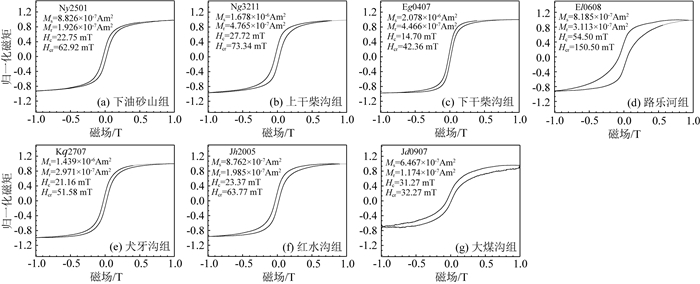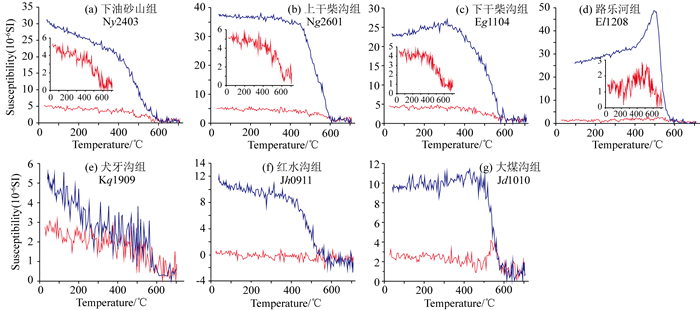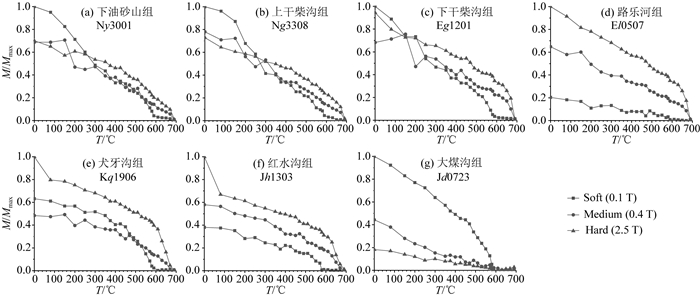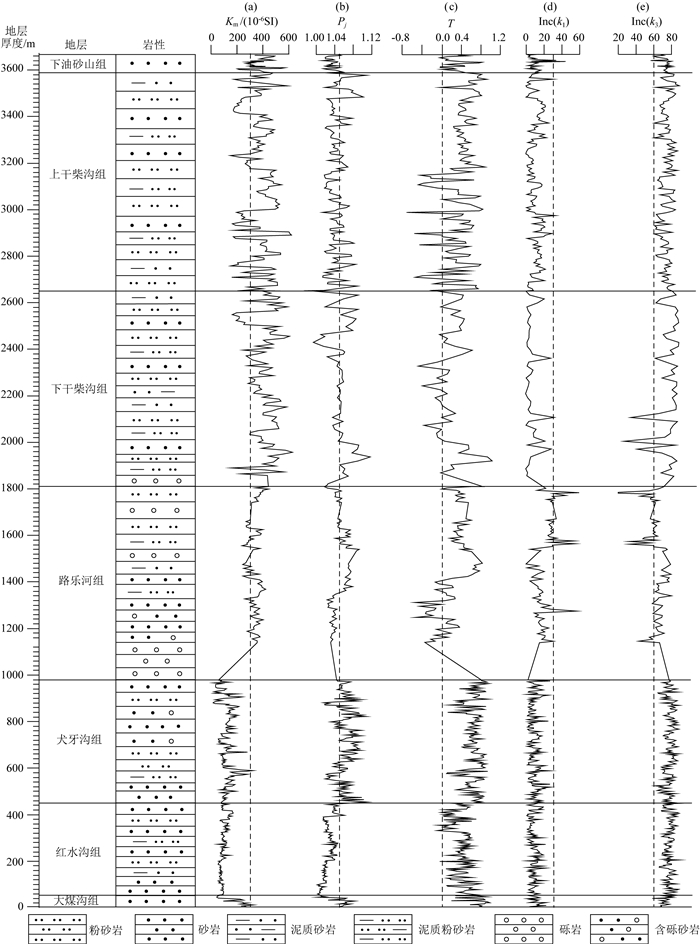中-新生代以来,印度-欧亚板块碰撞造就了喜马拉雅造山带(常承法等,1973;Chang et al., 1986;Dewey et al., 1989;Yin and Harrison, 2000;黄宝春等,2010),之后板块之间继续汇聚,致使欧亚大陆南北向缩短,形成巨厚的陆壳体(Molnar and Tapponnier, 1975;许志琴等, 2006a, b,2011).印度板块持续向欧亚大陆的俯冲导致高原周围造山带的抬升(许志琴等,1999).位于高原东北部的柴达木盆地,具有特有的“盆-山”地貌格局(吴汉宁等,1997;Li et al., 2018),它的形成演化与其周边造山带息息相关,盆地中巨厚的陆相沉积物记载着与周边造山带的构造隆升以及块体的旋转运动相关的信息.
沉积岩古水流方向受其周边古地貌的影响,在沉积盆地的物源方向总体不变的情况下,古水流方向的系统变化反映了沉积盆地的旋转(Hamilton and Rees, 1970;吴汉宁,1988;丛友滋等,1997;邓秀芹等,2007).沉积岩的磁组构,也称磁化率各向异性(AMS,Anisotropy of Magnetic Susceptibility)受控于沉积时的地球重力场与水动力作用,因此盆地中沉积岩的原始磁组构特征可作为古水流方向的判别依据,进而了解盆地的旋转运动.柴达木盆地北部路乐河沿岸发育有连续的中生代晚期和新生代沉积地层,其东北部的祁连山褶皱隆起带是长期相对稳定的物源供应区(李高杰等,2017;钱涛等,2018;Lu et al., 2018;Liu et al., 2019).通过对其进行系统的磁组构研究,分析其古水流方向系统变化,重塑盆地系统的旋转历史,有助于理解青藏高原东北部的构造演化过程、板块碰撞挤压远程效应在该区的响应.
1 研究区地质背景与样品采集柴达木盆地位于青藏高原东北部,是高原内最大的山间盆地(图 1a),其在形成演化过程中主要受控于祁连山、东昆仑山和阿尔金山三大断裂系统(图 1b)(Molnar and Tapponnier, 1975;Wang,1997;Métivier et al., 1998;Yin and Harrison, 2000;汤良杰等,2002).盆地内中、新生代沉积岩层非常发育,特别是新生代地层厚度最大处可达约13000m(吴婵等,2013;杜忠明等,2016)(图 1).

|
图 1 (a) 青藏高原地质构造简图及柴达木盆地区域位置图;(b)柴达木盆地地质构造简图;(c)研究区地质图;(d)研究区剖面图(图 1a、1b修改自Li et al.(2018);图 1c修改自付锁堂等(2013)) NQMTB:柴北缘冲断带;ATF:阿尔金断裂;KLF:昆仑断裂;QB:柴达木盆地;JSF:金沙江缝合带;BNF:班公湖-怒江缝合带. Fig. 1 (a) Simplified geological map of the Tibetan Plateau with major faults and the regional location of the Qaidam Basin; (b) Digtital elevation model (DEM) of the Qaidam Basin with major thrusts and strike-slip faults and the Location of the study section; (c) Geological map of the study section; (d) Cross section across the study area (see its position in (c) as A-A′). (Fig. 1a and 1b modified from Li et al.(2018); Fig. 1c modified from Fu et al.(2013)). NQMTB: The northern Qaidam marginal thrust belt; ATF: Altyn Tagh Fault; KLF: Kunlun Fault; QB: Qaidam Basin; JSF: Jinshajiang Fault; BNF: Bangong-Nujiang Fault. |
研究区路乐河剖面(38°09′N、94°38′E)位于柴达木盆地北缘大柴旦镇鱼卡以西40 km路乐河沿岸(图 1c),是一个褶皱轴为NW-SE向的背斜,褶皱轴走向与柴北缘冲断带走向基本平行.背斜发育在红水沟组(J3h)地层中,为一轻微倒转背斜,该背斜的南北两翼层序完整、构造简单.其中南翼包含约5000 m的连续的新生代沉积序列,是整个柴达木盆地最完整的新生代序列之一.新生代地层不整合于下伏白垩纪地层之上,因遭受断裂活动和褶皱变形,地层产状近乎直立和轻微倒转(图 1d).对该背斜两翼的新生代地层及下伏的中-晚中生代地层进行系统采样.该剖面总体沿河展布,由北向南地层变新,自下而上包括大煤沟组(厚度51.5 m)、红水沟组(厚度396.3 m)、犬牙沟组(厚度530.4 m)、路乐河组(厚度832.4 m)、下干柴沟组(厚度837.3 m)、上干柴沟组(厚度938.6 m)、下油砂山组(厚度86.3 m) (图 1c、1d),各组岩性特征如下:
下油砂山组(N21y):岩性以浅灰色泥质砂岩、砂岩为主,夹砾状砂岩、砂质泥岩、灰质泥岩和砾岩;
上干柴沟组(N1g):上部以灰色、杂色泥质砂岩、砂质泥岩为主,夹钙质泥岩、砂岩;下部以灰色、杂色泥质粉砂岩为主,夹灰绿色砂质泥岩和钙质泥岩;
下干柴沟组(E3g):上部以浅灰色泥质粉砂岩、泥质细砂岩为主,夹少量杂色钙质泥岩;下部为浅棕色、灰绿色泥质粉砂岩夹砂质泥岩;底部为一套棕红色砾岩,与路乐河组整合接触,具有明显的侵蚀面;与上干柴沟组相比,下干柴沟组颜色总体偏红,且砂岩含量明显增多;
路乐河组(E1-2l):上部以棕红色、浅红色泥质粉砂岩为主,夹泥质细砂岩、砾岩;中部以紫红色、土黄色泥质砂岩为主,夹大量厚层砾岩;下部以淡棕色块状砾岩为主,夹砾状砂岩,与犬牙沟组平行不整合接触;
犬牙沟组(K1q):上部为浅灰-红棕色砂岩、含砾砂岩及紫灰色泥质粉砂岩、砂质泥岩;下部为灰绿色、浅灰色的泥质细砂岩与泥质粉砂岩,夹少许不规则含砾砂岩、砂质泥岩与泥岩薄层,与红水沟组不整合接触;
红水沟组(J3h):上部以砖红色泥岩为主;下部主要为绿黄色砂岩与砂质泥岩;底部为一层含砾石砂岩;
大煤沟组(J2d):上部以浅黑灰色页岩为主,夹少量黄色沥青;下部以棕灰色、浅灰色砂岩及黑灰色炭质泥岩为主,夹少量劣质煤层.
根据实际地层出露结果,对各组地层出露良好的层位(不包括砂砾层)以0.2~3.0 m间距进行相对连续地采样,岩性较粗、出露情况较差的层位采样间隔则适当增大.样品采用便携式Mode1D26-C钻机人工钻取,磁罗盘独立定向,共采集1240块样品,在室内加工成标准圆柱形样品1100块,对其进行磁组构实验,并在每组地层中挑选代表性样品进行磁滞回线、k-T曲线和三轴等温剩磁退磁曲线测试.
2 岩石磁学 2.1 磁滞回线磁滞回线的测试采用振动样品磁力仪(MicroMag3900 VSM)完成,外加磁场为±1.0 T.路乐河剖面代表样品的磁滞特征(顺磁校正后)如图 2显示,大部分样品在500~800 mT之间闭合(图 2a-c,e-f),呈现轻微的“鹅颈”状,表明样品中可能同时含有高矫顽力组分和低矫顽力组分,且以高矫顽力组分为主(Tauxe et al., 1996).少部分样品直至1.0 T闭合(图 2d,图 2g),具有明显的“细腰”特征,表明样品中同时含有高矫顽力磁性矿物和低矫顽力磁性矿物(Roberts et al., 1995).

|
图 2 代表性样品顺磁校正后的磁滞回线 Fig. 2 Hysteresis loops after high-field slope correction for representative samples |
磁化率随温度变化(k-T)曲线的测试是采用Agico公司生产的MFK1-FA型卡帕桥多频各向异性磁化率仪上完成的.在氩气环境中,将代表性样品从室温逐步加热至700 ℃,再逐步冷却回室温,获得这个过程中磁化率与温度的关系曲线,判断样品中的主要磁性矿物.从图 3可以看出,所有代表性样品的初始磁化率都较低,且随温度升高持续降低,表明亚铁磁性矿物含量较少,可能以高矫顽力的铁磁性或者反铁磁性矿物为主,这与磁滞回线所表现的特征是相吻合的,所有样品的降温曲线明显高于升温曲线,表明样品中的一些矿物在温度升高的过程中发生了转变,生成了大量的强磁性矿物,一般是含铁的硅酸盐或者黏土矿物转变为磁铁矿颗粒(Deng et al., 2001).所有样品的加热曲线在580 ℃附近都表现出下降趋势,表明样品中含有磁铁矿,所有样品在680 ℃附近磁化率降至最低,指示赤铁矿的存在.另外,红水沟组典型样品的k-T曲线显示磁化率很弱(图 3f),可能是由于地层中粗粒成分含有的磁性矿物很少导致的.

|
图 3 代表性样品的磁化率随温度变化(k-T)曲线 红线代表升温过程;蓝线代表降温过程. Fig. 3 Temperature-dependent magnetic susceptibilities (k-T curves) for representative samples Red lines represent heating curves; blue lines represent cooling curves. |
通过对样品分别沿Z,Y,X三个轴分别施加2.5 T,0.4 T,0.1 T的磁场后进行系统热退磁,脉冲场施加使用ASC IM-10-30脉冲磁力仪,剩磁测量使用JR-6A双速旋转磁力仪.图 4为代表性样品的三轴等温剩磁退磁结果,从图中可以看出,所有样品的低矫顽力组分在580~600 ℃解阻,表明磁铁矿是重要的载磁矿物;而中、高矫顽力组分在670~690 ℃左右解阻,说明赤铁矿也是重要的载磁矿物.部分样品的高矫顽力组分热退磁曲线斜率在80 ℃左右发生变化(图 4e,4f),说明针铁矿的存在.

|
图 4 代表性样品的三轴等温剩磁逐步热退磁曲线 Fig. 4 Progressive thermal demagnetization of composite IRMs of representative samples |
磁组构(anisotropy of magnetic susceptibility,AMS)测试使用捷克Agico公司生产的MFK1-FA多频各向异性磁化率仪.对路乐河剖面中-新生代地层7个组共1100块标准古地磁样品进行AMS测试,获得其磁化率椭球体3个主轴(K1、K2和K3,分别对应样品的最大、中间和最小磁化率主轴)的大小和方位,计算出磁面理F、磁线理L、扁率E、校正的磁化率各向异性度Pj及磁化率椭球形状因子T等磁组构特征参数并绘制了相关分析图.AMS等面积投影图(地层坐标系下)(图 5、表 1)显示,各组地层K1、K2、K3方向比较集中,最小轴K3投影近圆心分布,基本垂直于层面,K1-K2面(磁面理)与层面基本平行(≤11°).Flinn图解显示,各组样品大多数位于扁圆状区域内,表明磁面理相对磁线理更发育,T-Pj图显示,各组样品大多数位于0<T<1的范围内,指示磁化率椭球以扁圆状为主,同时各组地层大多数样品的Pj<1.05;而且中生代与新生代地层相比,中生代各组地层落在0<E<1及-1<T<0区间的样品占该组样品的比例明显减少,显示了更加明显的沉积组构,同时也证明了中-新生代地层受后期扰动较小,是初始沉积磁组构(Liu et al., 2001;裴军令等,2008;张志亮等,2013;孔艳芬,2018),最大轴K1方向反映了沉积动力条件相对稳定的古水流方向.

|
图 5 路乐河剖面磁化率主轴地层坐标系下等面积投影图(下半球)(左)、Flinn图解(中)、T-Pj图解(右) Fig. 5 Stereographic projection of anisotropy of magnetic susceptibility ellipsoid under paleogeographic coordinate (lower hemisphere) (left), Flinn diagrams of magnetic foliation (F) and lineation (L) (middle) and T-Pj diagrams (right) of susceptibility of anisotropy of Lulehe section |
|
|
表 1 路乐河剖面各组地层磁组构特征参数平均值(地层坐标系下) Table 1 Mean values of AMS parameters from Lulehe section (paleogeographic coordinate) |
从磁组构各参数随地层变化曲线图(图 6)可看出:与新生代地层相比,中生代地层平均磁化率Km整体较低,几乎全部小于300×10-6SI,分别对应着大煤沟组的黄灰色砂岩、红水沟组的绿黄色砂岩、砂质泥岩及犬牙沟组的浅灰-红棕色砂岩;新生代样品平均磁化率Km明显增大,可能与新生代地层形成时沉积环境和沉积物颗粒类型发生较大变化有关.Km与Pj不同程度的正相关,反映了沉积物非等轴状颗粒在水流作用下的优选排列程度,水流作用增强而使磁化率各向异性度Pj更为明显.T值总体大于零,处于扁圆状区域,呈现出典型的沉积压实组构特征.整个剖面磁化率主轴K1和K3分布特征变化小,只有路乐河组的上半段略有变化(图 5j和图 6e),可能与路乐河组采样位置分布于一个微断层两侧有关.

|
图 6 路乐河剖面磁组构参数随地层变化图 (a)平均磁化率Km; (b)修正磁化率各向异性Pj; (c)磁化率椭球形状因子T; (d)最大磁化率主轴倾角; (e)最小磁化率主轴倾角. Fig. 6 Variation of AMS parameters for the Lulehe Section (a) Mean magnetic susceptibility Km; (b) Corrected AMS degree Pj; (c) AMS shape parameter T; (d) Inclinations of maximum principal axes of the AMS ellipsoids; (e) Inclinations of minimum principal axes of the AMS ellipsoids. |
沉积物的原生磁组构特征主要受沉积时水动力和重力作用的控制,重力作用使得面理发育,水动力作用使颗粒的长轴方向顺着水流方向排列,磁化率椭球体最大轴K1的方向与水流方向一致.为寻找本研究区沉积-构造总体规律,我们去除Pj>1.05及-1<T<0的个别异常点后,利用磁化率最大轴K1方向数据绘制了玫瑰花图(图 7),揭示了研究区七个不同时代连续地层单元的古水流方向系统变化特征.

|
图 7 路乐河剖面各组地层沉积时期K1主轴方向分布玫瑰图 N代表样品个数,点线代表地层产状方向. Fig. 7 Rose diagrams of distribution of K1 for the (a) Dameigou, (b) Hongshuigou, (c) Quanyagou, (d) Lulehe, (e) Xiaganchaigou, (f) Shangganchaigou and (g) Xiayoushashan Formations on Lulehe section N is the number of samples; dotted lines: sedimentary bedding. |
研究结果(图 7、表 2)表明,自中侏罗统大煤沟组(J2d)至下中新统下油砂山组(N21y)沉积期间,古水流方向共经历了4次阶段性转变,相应地指示了块体旋转方向的4次变化.在中-晚侏罗世(大煤沟组(J2d)至红水沟组(J3h)阶段)古水流方向变化了约22°,指示块体逆时针旋转了约22°;同理,至早白垩世(犬牙沟组(K1q)阶段),块体发生了近65°的顺时针旋转;到65.5~32Ma(路乐河组(E1-2l)至下干柴沟组(E3g)阶段),块体旋转方向再次改变,发生了约63°的逆时针旋转;在32~13 Ma(上干柴沟组(N1g)至下油砂山组(N21y)阶段)块体发生了约50°的顺时针旋转.
|
|
表 2 路乐河剖面中-新生代各组地层古水流方向统计结果 Table 2 Statistical results of paleocurrent directions during the Mesozoic-Cenozoic for Lulehe section |
利用构造古地磁(剩磁)方法研究盆地(块体)的旋转,已有不少成功的经验.对柴达木地区我们也进行过尝试性研究(吴汉宁等,1997),近年来有更多的研究者利用剩磁方向系统变化对柴达木盆地开展了卓有成效的关于盆地旋转的研究(表 3).这些研究者均在盆地内某段地层中成功的获得了某个时间段(点)盆地旋转的证据.
|
|
表 3 柴达木盆地古地磁研究结果 Table 3 Paleomagnetic Rotations of the Qaidam Basin |
有研究者指出在相对较长的时间段内计算古地磁结果平均值的方法具有局限性,以采点为单位得到的平均值可能掩盖了真实的旋转变化情况(Yan et al., 2013;Li et al., 2018).与构造古地磁的研究结果比较,磁组构特征的研究可以在更大时间跨度内更连续地获得盆地旋转方向系统变化的细节信息(裴军令等,2008;张志亮等,2013;Li et al., 2018).从本连续剖面得到的磁组构特征的系统变化,可能比较完整地记录了青藏高原东北部在中-新生代的构造演化过程信息.
大煤沟组(J2d)至红水沟组(J3h)沉积期间,古水流方向在总体向南的基础上变化了约22°,不仅说明当时研究区总体呈现北高南低的构造态势,更指示了盆地在该时间段内发生了逆时针旋转.至下白垩统犬牙沟组(K1q)沉积时期,古水流方向转变为SEE向,盆地在该时间段发生达65°的顺时针旋转,表明研究区古地貌发生了明显变化,地势为北西高南东低.在该时间段盆地由逆时针旋转改变为顺时针旋转,反映了盆地从伸展型构造背景转换为挤压型山前盆地(王大华等,2016).柴达木盆地总体处于挤压环境中,是由于来自冈瓦纳大陆的拉萨地块沿班公湖-怒江一线俯冲拼贴到北部羌塘地块,而高原的北部、东部分别受到塔里木-阿拉善地块和扬子板块的阻挡(王信国等,2006).在周边块体的挤压下,盆地发生顺时针旋转,引起阿尔金断裂发生大规模的左旋走滑运动并快速隆升,同时起转换作用的祁连山北缘逆冲断层开始形成,祁连山西端开始抬升(李海兵等,2006;王国灿等,2011),使得柴达木盆地北缘呈现出北西高南东低的地貌特征.
白垩纪早期以后(犬牙沟组(K1q)-路乐河组(E1-2l)-下干柴沟组(E3g)),盆地再次发生反方向的旋转(逆时针旋转约63°).在约65~55 Ma,印度-欧亚板块发生拼贴碰撞,碰撞产生的巨大应力经陆内拉萨、羌塘等刚性块体远程传递,导致祁连山-南山自西向东发生快速隆升(Jolivet et al., 2001;Ji et al., 2017),塞北断裂及柴北缘断裂开始形成(Yin et al., 2008),研究区地势总体为北高南低.持续至49~32 Ma(下干柴沟组(E3g)沉积期),印度板块继续向北推挤,使已经拼合的块体横向缩短、地壳加厚,引起逆冲推覆构造发育及盆地逆时针旋转,并导致阿尔金断裂发生右旋走滑运动(李高杰等,2017;Li et al., 2018).在此期间,虽然盆地承受来自南部诸块体的挤压,但盆地的逆时针旋转可能发生于高原隆升后边部松弛引起的局部伸展环境中.
在32~13 Ma,古水流方向的系统变化表明块体再次改变旋转方向,转变为顺时针方向,旋转角度达50°.早渐新世至早中新世期间,在印度-欧亚板块持续的近南北向挤压作用下,盆地处于挤压环境中,并发生顺时针旋转(Ji et al., 2017;Li et al., 2018),同时阿尔金断裂再次发生左旋走滑运动并继续向北东扩展,阿尔金山初始形成,受走滑位移影响,祁连山地区系列逆冲断层继续强烈活动(Sun et al., 2005;Yin et al., 2008;王国灿等,2011;Bush et al., 2016),并伴随祁连山和柴达木盆地的整体快速隆升(Wang et al., 2017),研究区地势随之发生变化,总体表现为北西高南东低.
6 结论(1) 岩石磁学研究表明,路乐河剖面中、新生代沉积岩中的磁性矿物主要为赤铁矿和磁铁矿,部分样品含有少量的针铁矿.柴达木盆地路乐河剖面连续分布的中-新生代地层均保留了初始沉积磁组构特征,其磁化率椭球体最大轴方向指示了古水流方向.
(2) 磁组构特征指示自中侏罗统大煤沟组(J2d)至早中新统下油砂山组(N21y)沉积时期,盆地中古水流方向共经历了4次阶段性变化,古水流方向的系统变化揭示了块体相应的4次旋转.在中-晚侏罗世块体逆时针旋转了约22°;至早白垩世,块体顺时针旋转了近65°;到65.5~32 Ma块体旋转方向再次改变,发生了约63°的逆时针旋转;在32~13 Ma块体发生了约50°的顺时针旋转.
(3) 柴达木块体的旋转可能是受复杂的大地构造背景和深部因素影响.目前看来,在拉张环境下的逆时针旋转和挤压环境中的顺时针旋转,可能与其南的羌塘块体、拉萨块体和印度板块阶段性北向碰撞挤压紧密相关.拉张环境与挤压环境的多次转换可能与中特提斯的关闭、新特提斯的张开及闭合、高原快速隆升后在其边部发生松弛作用相联系.柴达木块体旋转方向的多次改变,可能与块体周边的大型走滑断裂带(如阿尔金断裂、祁连山北缘断裂等)走滑方向多次改变相关.
Bush M A, Saylor J E, Horton B K, et al. 2016. Growth of the Qaidam Basin during Cenozoic exhumation in the Northern Tibetan Plateau:Inferences from depositional patterns and multiproxy detrital provenance signatures. Lithosphere, 8(1): 58-82. DOI:10.1130/L449.1 |
Chang C F, Zheng X L. 1973. Tectonic features of the mount Jolmo Lungma region in southern Tibet, China. Scientia Geologica Sinica (in Chinese), (1): 1-12. |
Chang C F, Chen N S, Coward M P, et al. 1986. Preliminary conclusions of the Royal Society and Academia Sinica 1985 geotraverse of Tibet. Nature, 323(6088): 501-507. DOI:10.1038/323501a0 |
Chen Y, Gilder S, Halim N, et al. 2002. New paleomagnetic constraints on central Asian kinematics:Displacement along the Altyn Tagh fault and rotation of the Qaidam Basin. Tectonics, 21(5): 6-1-6-19. DOI:10.1029/2001TC901030 |
Cong Y Z, Han G Z, Li C X, et al. 1997. Magnetic fabric characteristics of tidal mud flat and its study significance. Marine Geology & Quaternary Geology (in Chinese), 17(1): 14-17. |
Deng C L, Zhu R X, Jackson M J, et al. 2001. Variability of the temperature-dependent susceptibility of the Holocene eolian deposits in the Chinese loess plateau:A pedogenesis indicator. Physics and Chemistry of the Earth, Part A:Solid Earth and Geodesy, 26(11-12): 873-878. DOI:10.1016/S1464-1895(01)00135-1 |
Deng X Q, Liu X S, Hui X, et al. 2007. The principle and application of magnetic fabric to paleocurrent estimation of drilling cores. Journal of Northwest University (Natural Science Edition) (in Chinese), 37(6): 896-900. |
Dewey J F, Cande S C, Pitman W C. 1989. Tectonic evolution of the India/Eurasia collision zone. Eclogae Geologicae Helvetiae, 82(3): 717-734. |
Du Z M, Fan L G, Wu G L, et al. 2016. Cenozoic architecture and structural development of the eastern Qaidam basin. Chinese Journal of Geophysics (in Chinese), 59(12): 4560-4569. |
Dupont-Nivet G, Butler R F, Yin A, et al. 2002. Paleomagnetism indicates no Neogene rotation of the Qaidam Basin in northern Tibet during Indo-Asian collision. Geology, 30(3): 263-266. DOI:10.1130/0091-7613(2002)030〈0263:PINNRO〉2.0.CO;2 |
Fang X M, Zhang W L, Meng Q Q, et al. 2007. High-resolution magnetostratigraphy of the Neogene Huaitoutala section in the eastern Qaidam Basin on the NE Tibetan Plateau, Qinghai Province, China and its implication on tectonic uplift of the NE Tibetan Plateau. Earth and Planetary Science Letters, 258(1-2): 293-306. DOI:10.1016/j.epsl.2007.03.042 |
Fu S T, Xiao A C, Wang L Q. 2013. Typical Geological Sections in the Qaidam Basin (in Chinese). Beijing: Science Press.
|
Hamilton N, Rees A I. 1970. Magnetic fabric of sediments from the shelf at La Jolla (California). Marine Geology, 9(2): M6-M11. DOI:10.1016/0025-3227(70)90060-5 |
Huang B C, Chen J S, Yi Z Y. 2010. Paleomagnetic discussion of when and where India and Asia initially collided. Chinese Journal of Geophysics (in Chinese), 53(9): 2045-2058. |
Ji J L, Zhang K X, Clift P D, et al. 2017. High-resolution magnetostratigraphic study of the Paleogene-Neogene strata in the Northern Qaidam Basin:Implications for the growth of the Northeastern Tibetan Plateau. Gondwana Research, 46: 141-155. DOI:10.1016/j.gr.2017.02.015 |
Jolivet M, Brunel M, Seward D, et al. 2001. Mesozoic and Cenozoic tectonics of the northern edge of the Tibetan Plateau:fission-track constraints. Tectonophysics, 343(1-2): 111-134. DOI:10.1016/S0040-1951(01)00196-2 |
Kong Y F, Sun L, Shen Z S, et al. 2018. Anisotropy of magnetic susceptibility of the Neogene Guonigou section in the Linxia Basin and its paleoenvironmental significance. Chinese Journal of Geophysics (in Chinese), 61(11): 4518-4529. |
Li B S, Yan M D, Zhang W L, et al. 2018. Paleomagnetic rotation constraints on the deformation of the northern Qaidam Marginal thrust belt and implications for strike-slip faulting along the Altyn Tagh Fault. Journal of Geophysical Research:Solid Earth, 123(9): 7207-7224. DOI:10.1029/2018JB015753 |
Li G J, Yi H S, Xia G Q, et al. 2017. Compositional variation of Cenozoic detritus in the Lulehe area, Qaidam Basin, and its implications for Tibetan Plateau tectonic uplift. Geological Bulletin of China (in Chinese), 36(6): 1022-1031. |
Li H B, Yang J S, Xu Z Q, et al. 2006. The constraint of the Altyn Tagh fault system to the growth and rise of the northern Tibetan plateau. Earth Science Frontiers (in Chinese), 13(4): 59-79. |
Liu B Q, Shao L Y, Wang X T, et al. 2019. Application of channel-belt scaling relationship to Middle Jurassic source-to-sink system in the Saishiteng area of the northern Qaidam Basin, NW China. Journal of Palaeogeography, 8(2): 181-197. DOI:10.1186/s42501-019-0031-9 |
Liu B Z, Saito Y, Yamazaki T, et al. 2001. Paleocurrent analysis for the Late Pleistocene-Holocene incised-valley fill of the Yangtze Delta, China by using anisotropy of magnetic susceptibility data. Marine Geology, 176(1-4): 175-189. DOI:10.1016/S0025-3227(01)00151-7 |
Lu H J, Xiong S F. 2009. Magnetostratigraphy of the Dahonggou section, northern Qaidam Basin and its bearing on Cenozoic tectonic evolution of the Qilian Shan and Altyn Tagh Fault. Earth and Planetary Science Letters, 288(3-4): 539-550. DOI:10.1016/j.epsl.2009.10.016 |
Lu H J, Ye J C, Guo L C, et al. 2018. Towards a clarification of the provenance of Cenozoic sediments in the northern Qaidam Basin. Lithosphere, 11(2): 252-272. DOI:10.1130/L1037.1 |
Métivier F, Gaudemer Y, Tapponnier P, et al. 1998. Northeastward growth of the Tibet Plateau deduced from balanced reconstruction of two depositional areas:The Qaidam and Hexi Corridor basins, China. Tectonics, 17(6): 823-842. DOI:10.1029/98TC02764 |
Molnar P, Tapponnier P. 1975. Cenozoic Tectonics of Asia:Effects of a Continental Collision:Features of recent continental tectonics in Asia can be interpreted as results of the India-Eurasia collision. Science, 189(4201): 419-426. DOI:10.1126/science.189.4201.419 |
Pei J L, Sun Z M, Li H B, et al. 2008. Paleocurrent direction of the Late Cenozoic sedimentary sequence of the Tibetan plateau northwestern margin constrained by AMS and its tectonic implications. Acta Petrologica Sinica (in Chinese), 24(7): 1613-1620. |
Qian T, Wang Z X, Liu Y Q, et al. 2018. Provenance analysis of the Jurassic northern Qaidam Basin:Stratigraphic succession and LA-ICP-MS geochronology. Scientia Sinica Terrae (in Chinese), 48(2): 224-242. DOI:10.1360/N072017-00119 |
Rieser A B, Liu Y, Genser J, et al. 2006a. 40Ar/39Ar ages of detrital white mica constrain the Cenozoic development of the intracontinental Qaidam Basin, China. GSA Bulletin, 118(11-12): 1522-1534. DOI:10.1130/B25962.1 |
Rieser A B, Liu Y, Genser J, et al. 2006b. Uniform Permian 40Ar/39Ar detrital mica ages in the eastern Qaidam Basin (NW China):Where is the source?. Terra Nova, 18(1): 79-87. DOI:10.1111/j.1365-3121.2005.00666.x |
Roberts A P, Cui Y L, Verosub K L. 1995. Wasp-waisted hysteresis loops:Mineral magnetic characteristics and discrimination of components in mixed magnetic systems. Journal of Geophysical Research:Solid Earth, 100(B9): 17909-17924. DOI:10.1029/95jb00672 |
Sun Z C, Feng X J, Li D M, et al. 1999. Cenozoic Ostracoda and palaeoenvironments of the northeastern Tarim Basin, western China. Palaeogeography, Palaeoclimatology, Palaeoecology, 148(1-3): 37-50. DOI:10.1016/S0031-0182(98)00174-6 |
Sun Z M, Yang Z Y, Pei J L, et al. 2005. Magnetostratigraphy of paleogene sediments from northern Qaidam Basin, China:Implications for tectonic uplift and block rotation in northern Tibetan plateau. Earth and Planetary Science Letters, 237(3-4): 635-646. DOI:10.1016/j.epsl.2005.07.007 |
Tang L J, Jin Z J, Dai J S, et al. 2002. Regional fault systems of Qaidam Basin and adjacent orogenic belts. Earth Science-Journal of China University of Geosciences (in Chinese), 27(6): 676-682. |
Tauxe L, Mullender T A T, Pick T. 1996. Potbellies, wasp-waists, and superparamagnetism in magnetic hysteresis. Journal of Geophysical Research:Solid Earth, 101(B1): 571-583. DOI:10.1029/95jb03041 |
Wang D H, Wang J D, Xiao Y J, et al. 2016. Structure modeling and evolution of piedmont zone in Dachaidan area, north margin of Qaidam Basin. Earth Science Frontier (in Chinese), 23(5): 1-10. |
Wang E. 1997. Displacement and timing along the northern strand of the Altyn Tagh fault zone, Northern Tibet. Earth and Planetary Science Letters, 150(1-2): 55-64. DOI:10.1016/s0012-821x(97)00085-x |
Wang G C, Cao K, Zhang K X, et al. 2011. Spatio-temporal framework of tectonic uplift stages of the Tibetan Plateau in Cenozoic. Science China Earth Sciences, 54(1): 29-44. |
Wang W T, Zheng W J, Zhang P Z, et al. 2017. Expansion of the Tibetan Plateau during the Neogene. Nature Communications, 8: 15887. DOI:10.1038/ncomms15887 |
Wang X G, Cao D Y, Zhan W F, et al. 2006. The Meso-Cenozoic basin type and tectonic evolution in the northern margin region of the Qaidam Basin. Geoscience (in Chinese), 20(4): 592-596. |
Wu C, Yan C F, Li H B, et al. 2013. Cenozoic tectonic evolution of the western Qaidam Basin and its constrain on the growth of the northern Tibetan Plateau. Acta Petrologica Sinica (in Chinese), 29(6): 2211-2222. |
Wu H N. 1988. Magnetic fabric and its application to strain analysis. Acta Petrologica Sinica (in Chinese), 4(1): 96-100. |
Wu H N, Liu C Y, Zhang X H, et al. 1997. Study on tectonic evolution of Qaidam block with paleomagnetic data. Science in China (Series D) (in Chinese), 27(1): 11-16. |
Xu Z Q, Yang J S, Jiang M. 1999. Continental subduction and uplifting of the orogenic belts at the margin of the Qinghai-Tibet plateau. Earth Science Frontiers (in Chinese), 6(3): 139-151. |
Xu Z Q, Li H B, Yang J S. 2006a. An orogenic plateau-the orogenic collage and orogenic types of the Qinghai-Tibet plateau. Earth Science Frontiers (in Chinese), 13(4): 1-17. |
Xu Z Q, Yang J S, Li H B, et al. 2006b. The Qinghai-Tibet plateau and continental dynamics:A review on terrain tectonics, collisional orogenesis, and processes and mechanisms for the rise of the plateau. Geology in China (in Chinese), 33(2): 221-238. |
Xu Z Q, Yang J S, Li H B, et al. 2011. On the tectonics of the India-Asia collision. Acta Geologica Sinica (in Chinese), 85(1): 1-33. DOI:10.1111/j.1755-6724.2011.00375.x |
Yan M D, Fang X M, Van Der Voo R, et al. 2013. Neogene rotations in the Jiuquan Basin, Hexi Corridor, China. Geological Society, London, Special Publications, 373(1): 173-189. DOI:10.1144/SP373.6 |
Yang F. 1988. Distribution of the Brackish-salt Water Ostracods in Northwestern Qinghai plateau and its geological significance. Developments in Palaeontology and Stratigraphy, 11: 519-530. DOI:10.1016/S0920-5446(08)70205-X |
Yang F, Ma Z Q, Xu T C, et al. 1992. A Tertiary paleomagnetic stratigraphic profile in Qaidam basin. Acta Petrolei Sinica (in Chinese), 13(2): 97-101. DOI:10.7623/syxb199202016 |
Yin A, Harrison T M. 2000. Geologic evolution of the Himalayan-Tibetan Orogen. Annual Review of Earth and Planetary Sciences, 28: 211-280. DOI:10.1146/annurev.earth.28.1.211 |
Yin A, Dang Y Q, Wang L C, et al. 2008. Cenozoic tectonic evolution of Qaidam basin and its surrounding regions (part 1):The southern Qilian Shan-Nan Shan thrust belt and northern Qaidam basin. GSA Bulletin, 120(7-8): 813-846. DOI:10.1130/b26180.1 |
Yu X J, Fu S T, Guan S W, et al. 2014. Paleomagnetism of Eocene and Miocene sediments from the Qaidam basin:implication for no integral rotation since the Eocene and a rigid Qaidam block. Geochemistry, Geophysics, Geosystems, 15(6): 2109-2127. DOI:10.1002/2014GC005230 |
Zhang Z L, Shen Z Y, Wang X, et al. 2013. Characteristics of magnetic fabrics and paleocurrent directions of Cenozoic sediments in the Kelasu River, Kuqa Depression. Chinese Journal of Geophysics (in Chinese), 56(2): 567-578. |
常承法, 郑锡澜. 1973. 中国西藏南部珠穆朗玛峰地区构造特征. 地质科学, (1): 1-12. |
丛友滋, 韩国忠, 李从先, 等. 1997. 泥质潮坪磁组构特征及其意义研究. 海洋地质与第四纪地质, 17(1): 14-17. DOI:10.16562/j.cnki.0256-1492.1997.01.002 |
邓秀芹, 刘新社, 惠潇, 等. 2007. 岩心磁组构分析古水流方向的原理与应用. 西北大学学报(自然科学版), 37(6): 896-900. DOI:10.16152/j.cnki.xdxbzr.2007.06.015 |
杜忠明, 樊龙刚, 武国利, 等. 2016. 柴达木盆地东部新生代盆地结构与演化. 地球物理学报, 59(12): 4560-4569. DOI:10.6038/cjg20161218 |
付锁堂, 肖安成, 汪立群. 2013. 柴达木盆地典型构造剖面. 北京: 科学出版社.
|
黄宝春, 陈军山, 易治宇. 2010. 再论印度与亚洲大陆何时何地发生初始碰撞. 地球物理学报, 53(9): 2045-2058. DOI:10.3969/j.issn.0001-5733.2010.09.005 |
孔艳芬, 孙蕗, 沈中山, 等. 2018. 临夏盆地新近纪郭泥沟剖面磁组构特征及其环境意义. 地球物理学报, 61(11): 4518-4529. DOI:10.6038/cjg2018M0245 |
李高杰, 伊海生, 夏国清, 等. 2017. 柴达木路乐河地区新生代碎屑组分变化及其对构造隆升的指示. 地质通报, 36(6): 1022-1031. DOI:10.3969/j.issn.1671-2552.2017.06.014 |
李海兵, 杨经绥, 许志琴, 等. 2006. 阿尔金断裂带对青藏高原北部生长、隆升的制约. 地学前缘, 13(4): 59-79. DOI:10.3321/j.issn:1005-2321.2006.04.006 |
裴军令, 孙知明, 李海兵, 等. 2008. 青藏高原西北缘晚新生代沉积岩古流向的磁化率各向异性确定及其构造意义. 岩石学报, 24(7): 1613-1620. |
钱涛, 王宗秀, 柳永清, 等. 2018. 柴达木盆地北缘侏罗纪沉积物源分析:地层序列及LA-ICP-MS年代学信息. 中国科学:地球科学, 48(2): 224-242. DOI:10.1360/N072017-00119 |
汤良杰, 金之钧, 戴俊生, 等. 2002. 柴达木盆地及相邻造山带区域断裂系统. 地球科学-中国地质大学学报, 27(6): 676-682. DOI:10.3321/j.issn:1000-2383.2002.06.004 |
王大华, 王金铎, 肖永军, 等. 2016. 柴北缘大柴旦地区山前带构造建模及演化研究. 地学前缘, 23(5): 1-10. DOI:10.13745/j.esf.2016.05.001 |
王国灿, 曹凯, 张克信, 等. 2011. 青藏高原新生代构造隆升阶段的时空格局. 中国科学:地球科学, 41(3): 332-349. DOI:10.1007/s11430-010-4110-0 |
王信国, 曹代勇, 占文锋, 等. 2006. 柴达木盆地北缘中、新生代盆地性质及构造演化. 现代地质, 20(4): 592-596. DOI:10.3969/j.issn.1000-8527.2006.04.010 |
吴婵, 阎存凤, 李海兵, 等. 2013. 柴达木盆地西部新生代构造演化及其对青藏高原北部生长过程的制约. 岩石学报, 29(6): 2211-2222. |
吴汉宁. 1988. 岩石的磁性组构及其在岩石变形分析中的应用. 岩石学报, 4(1): 96-100. |
吴汉宁, 刘池阳, 张小会, 等. 1997. 用古地磁资料探讨柴达木地块构造演化. 中国科学(D辑), 27(1): 11-16. |
许志琴, 杨经绥, 姜枚. 1999. 大陆俯冲作用及青藏高原周缘造山带的崛起. 地学前缘, 6(3): 139-151. DOI:10.3321/j.issn:1005-2321.1999.03.014 |
许志琴, 李海兵, 杨经绥. 2006a. 造山的高原——青藏高原巨型造山拼贴体和造山类型. 地学前缘, 13(4): 1-17. |
许志琴, 杨经绥, 李海兵, 等. 2006b. 青藏高原与大陆动力学——地体拼合、碰撞造山及高原隆升的深部驱动力. 中国地质, 33(2): 221-238. |
许志琴, 杨经绥, 李海兵, 等. 2011. 印度/亚洲碰撞大地构造. 地质学报, 85(1): 1-33. |
杨藩, 马志强, 许同春, 等. 1992. 柴达木盆地第三纪磁性地层柱. 石油学报, 13(2): 97-101. DOI:10.7623/syxb199202016 |
张志亮, 沈忠悦, 汪新, 等. 2013. 库车坳陷克拉苏河新生代沉积岩磁组构特征与古流向分析. 地球物理学报, 56(2): 567-578. DOI:10.6038/cjg20130220 |
 2020, Vol. 63
2020, Vol. 63


